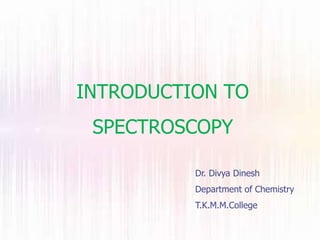Spectroscopy Introduction
Spectroscopy is the study of the interaction between electromagnetic radiation and matter such as atoms, molecules, or ions. It uses electromagnetic radiation of specific wavelengths or wavelength ranges to qualitatively or quantitatively analyze matter. Spectroscopy deals with absorption, emission, and scattering of electromagnetic radiation when it interacts with matter. The interaction depends on the energy of the radiation, with more energetic radiations like UV and x-rays potentially causing electron ejection, and less energetic ones like infrared inducing molecular vibrations or microwave causing molecular rotation. Spectroscopy is widely used to study the internal structure of organic and inorganic compounds and has advantages like being non-destructive, sensitive, and requiring small sample sizes.

Recommended
More Related Content
What's hot
What's hot (20)
Similar to Spectroscopy Introduction
Similar to Spectroscopy Introduction (20)
Recently uploaded
Recently uploaded (20)
Spectroscopy Introduction
- 1. INTRODUCTION TO SPECTROSCOPY Dr. Divya Dinesh Department of Chemistry T.K.M.M.College
- 2. Spectroscopy • Spectroscopy is the study of the interaction between electromagnetic radiation and matter. • The matter can be atoms, molecules or ions • It is a branch of Science in which electromagnetic radiation of particular wavelength or range of wavelength is used for qualitative or quantitative of matter Matter: • Anything which occupies space in universe and having mass
- 3. Electromagnetic radiation • Is a form of energy and has both electrical and magnetic characteristics • The electric and magnetic fields in electromagnetic wave oscillate along directions perpendicular to the propagation direction of the wave • E = hν and c = λν where ‘ν’ is pronounced as ‘nu’
- 5. • Frequency :- number of waves produced each second (measured in Hz). • Wavelength (λ) :- the distance between two successive waves (measured in m). • Amplitude :- is the maximum distance a wave extends beyond its middle position. Wavenumber (ν) :- the reciprocal of wavelength (measured in m-1). Properties of a wave
- 6. Applications of spectroscopy Extensively used to study the internal structure of matter, especially molecules of complex organic and inorganic compounds Advantages: Less time consuming Extremely sensitive Cost effective in long run Very small amount of sample is required non-destructive method, so entire sample can be recovered Highly reliable in establishing the identity of two compounds and provide more information about molecular structure
- 7. Spectroscopy deals with the interaction of electromagnetic radiation with matter
- 8. Absorption – Ground State to excited state Emission – excited state to ground state Absorption spectroscopy Emission spectroscopy
- 9. The nature of the interaction between radiation and matter may include- 1. absorption 2. emission 3. scattering …….. They help in the study of matter with respect to 1. qualitative study 2. quantitative study
- 10. Interaction with matter... • The effect of electromagnetic radiation on interaction with matter depends on energy associated with the radiation • Very energetic radiations (UV and x-ray) may cause an electron to be ejected from the molecules • Radiation in the infrared region of the spectrum have much less energy they can cause vibrations in molecules • Microwave radiation is even less energetic than infrared radiation it can neither induce electronic transition in molecules nor can it cause vibrations it can only cause molecules to rotate • Ultraviolet, visible - electronic transitions • Infrared - molecular vibrations • Microwave - molecular rotation